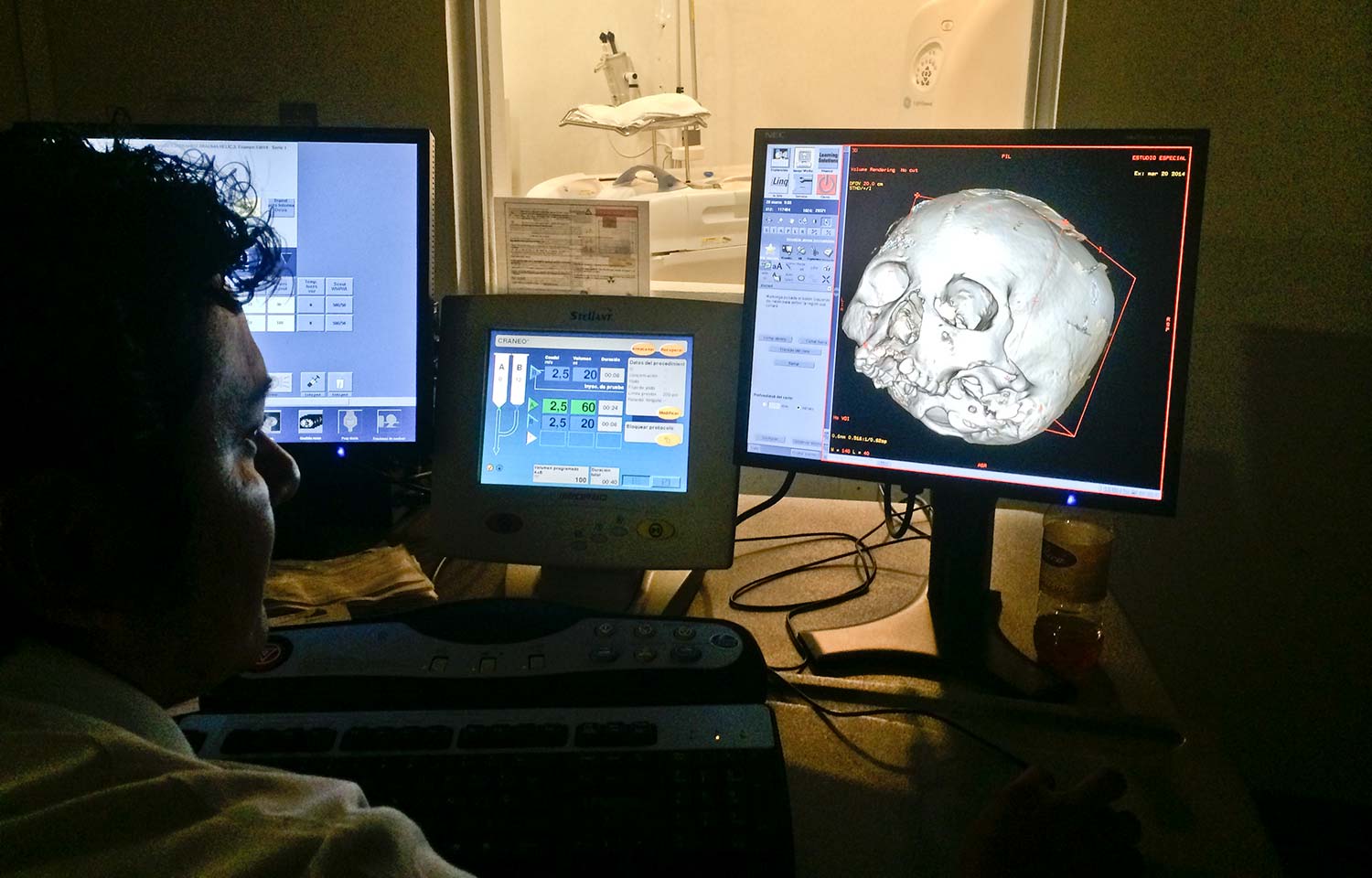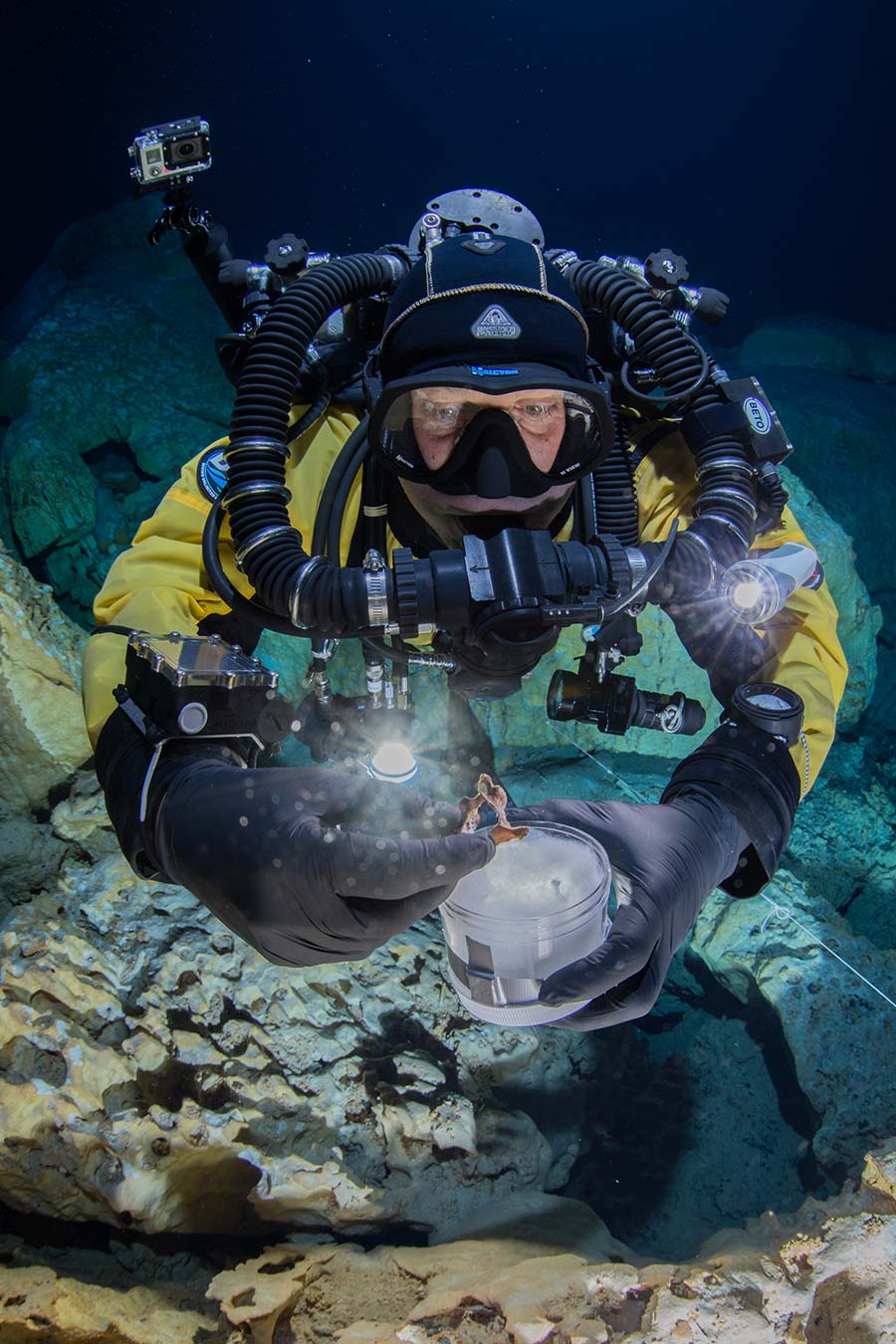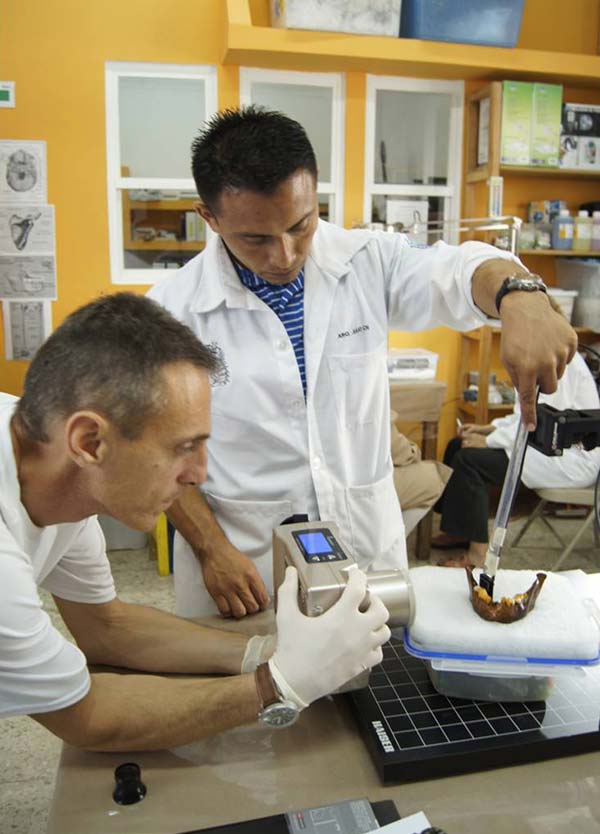UC San Diego Research Sheds New Light on Life of Ice Age American
Published Date
By:
- Tiffany Fox
Share This:
Article Content

Specialists in Campeche perform a CT scan of Naia's cranium. Photo by James C. Chatters
Together with their colleagues, researchers from the University of California San Diego have announced new findings about a skeleton nicknamed “Naia,” the earliest mostly complete human found so far in the Americas.
Various studies and analyses carried out in laboratories in Mexico, the United States and Canada have revealed that the remains are those of a girl between 15 and 16 years old who lived almost 13,000 years ago in what is now Mexico’s Yucatan peninsula. Multiple lines of evidence, including pubic bone features, suggest that Naia may have given birth months before she died after falling into the 50-meter deep hole known as Hoyo Negro, a site near Tulum, Quintana Roo.
James C. Chatters, a principal investigator and one of the co-directors of the Hoyo Negro Underwater Archaeology Project, announced the results at the 82nd annual conference of the Society for American Archaeology (SAA), which took place earlier this month in Vancouver, Canada. Chatters’ collaborators include fellow co-director Dominique Rissolo, a UC San Diego archaeologist and Special Projects Coordinator at the UC San Diego Qualcomm Institute Center of Interdisciplinary Science for Art, Architecture and Archaeology (CISA3) and its Cultural Heritage Engineering Initiative (CHEI). The lead director of the project is Pilar Luna Erreguerena of the Sub-Directorate of Underwater Archeology of the National Institute of Anthropology and History (INAH). In addition to INAH support for the Naia study, the project has received funding from the National Geographic Society and the Strauss Family Foundation, and has also partnered with Seattle Children’s Hospital.

Alberto Nava recovers a vertebra from Naia's skeleton. Photo by Roberto Chavez Arce
“Only five individuals in the Americas have been securely dated to this early period, more than 12,000 years ago,” says Rissolo. “Such studies are important since skeletal evidence of the First Americans is so rare and elusive. What makes Naia unique is that her skeleton is nearly complete and relatively well preserved. This has enabled our international and interdisciplinary team to perform a range of analyses that are revealing more about the life of a young Paleoamerican woman than we ever thought possible.”
Between 2014 and 2016 and in coordination with Mexican and international experts, a team of underwater cave explorers with training in underwater archaeological site documentation recovered 98 fragments of Naia’s skeleton. From each of these remains, X-rays and CT scans were taken at the Hospital de Especialidades in Mexico’s Campeche City.
In 2014, Chatters and his colleagues were able to confirm, using Naia’s DNA, that both the earliest American settlers and modern Native Americans are genetically linked to a single group of Asian emigrants. Scientists working on this project, including Chatters of Applied Paleoscience and DirectAMS in Washington State, and Vera Tiesler and Andrea Cucina of the Autonomous University of Yucatan, have revealed that Naia measured 152 centimeters and weighed a maximum of 50.4 kilos when well-fed, as the study of her teeth and long bones proved that she often went through periods of extreme nutritional stress.
According to experts, these findings suggest that the lives of the first settlers of the Americas, or at least some of these groups that came across the Bering Strait region of Siberia on modern day Alaska, were not idyllic. On the contrary, life was extremely challenging.
The Naia skeleton, which also bore evidence that Naia had healed from a previously broken arm, was discovered in 2007 by Alejandro Álvarez, Alberto Nava and Franco Attolini, members of the Tulum Speleological Project (PET), who together with Roberto Chávez Arce and other members of the PET have been key in the discovery not only of human remains but also of a large assemblage of extinct Pleistocene fauna, including gomphotheres (elephant-like creatures), saber-toothed cats, giant ground sloths, canids and bears, and other still extant animals such as tapirs, pumas, and bats, among others.

Andrea Cucina and Julio Chi Keb, of the Autonomous University of Yucatan, x-ray teeth from Naia's mandible. Photo by James C. Chatters
Much of the work that has led to a better understanding of Naia’s fate was done far from Hoyo Negro in UC San Diego’s Atkinson Hall. Computer science Ph.D. student Vid Petrovic – a member of the Center’s Integrative Graduate Education and Research Traineeship (IGERT) program in cultural heritage diagnostics – used two-dimensional photographs taken by the scientific dive team to 'stitch together' and reconstruct digitally 3D structure-from-motion (SfM) models of both the cave site and Naia’s skeleton.
“Our CISA3-CHEI team at UC San Diego, led by Falko Kuester, has extensive experience using photogrammetric techniques to document cultural heritage sites around the world,” noted Rissolo. “Hoyo Negro was especially difficult, given the depth, darkness, and complexity of the site. Alberto (Beto) Nava and Roberto Chavez led an extraordinary effort to image the site in the most challenging of conditions. They were the astronauts collecting imagery from inner-space, while we were the ones back at mission control transforming those data into information for the scientists to evaluate.”
In their Digital Heritage conference presentation published last year, the researchers wrote that “the implementation of different image acquisition methodologies at different scales (site, feature, and object) has resulted in geometrically accurate and complementary models of cave features as well as individual skeletal elements. These 3D digital (and printable) models have proven critical to current and ongoing morphometric and taphonomic analyses [i.e. the quantitative analysis of form and the study of the processes affecting organisms as they become fossilized], as many of the bones have not been removed from the cave.
“These data,” they continued, “will not only serve as documentation of the site, but will enable project researchers from across disciplines to evaluate and annotate the imagery remotely while guiding subsequent sampling and recovery activities.”
Share This:
Stay in the Know
Keep up with all the latest from UC San Diego. Subscribe to the newsletter today.



